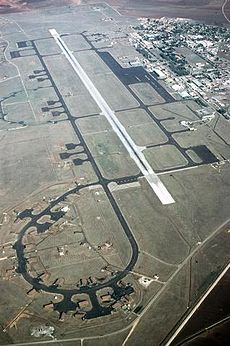Nuclear Weapons 703 - Vulnerabilities of Navy E-6 Mercury Command Aircraft
Incirlik_Air_Base_overhead_1987.jpg

The U.S. Navy designed the E-6 Mercury aircraft in conjunction with Boeing to control the U.S. arsenal in case of nuclear war. The E-6 is one hundred and fifty feet long, forty-two feet high and has a one hundred and forty-eight foot wingspan. It carries a crew of twenty-two and has a top speed of six hundred and ten miles per hour. It has a range of seven thousand six hundred miles and can stay in the air for ten hours without needed to refuel or seventy-two hours with multiple refueling. While the E-6 does not carry any weapons, it can act as a command and control airborne base for U.S. nuclear missile submarines, U.S. air force bombers and U.S. ICBM missile crews. The E-6 is intended to connect the U.S. President and defense secretary to the three legs of the U.S. nuclear arsenal if there is a nuclear war where ground-based communication systems are no longer available. The E-6 was put into operation in 1989.
In February of this year, the E-6 experienced a “Class-A” event when the tail of the plane clipped the top of a hangar. There was only a single person on the E-6 at the time of the event and no one was injured.
On October 2nd of this year, a bird was sucked into one of the four engines on the E-6. They had to replace the engine before the plane could be put back into service. There were at least two million dollars worth of damages caused by the bird. This is the second Class-A event this year and the fifth Class-A event involving a bird in the past ten years.
It seems to me that this is a serious problem with the reliability and safety of the E-6. If a bird can force the E-6 to land, that means that the flying Navy command and control center might not be able to carry out its mission. If a bird can take out the E-6, it would indicate that a small drone might also be able to bring down the E-6. There is a great deal of research these days into swarms of drones that can act in a coordinated manner. A cloud of drones could attack an E-6 by using infrared detectors to home in on the plane’s engines which would be hotter than any other part of the plane.
Of course, the exact defensive equipment on the E-6 is classified and not available for public dissemination. It may very well be that the E-6 does have defense against coordinated swarms of drones. However, since the existence of offensive drone swarms is a very recent development, defenses against such a threat are not well developed at this time and may not be part of the current design of the E-6.
Drone swarms can be carried in and deployed from a semi-truck. The base of the E-6 is public knowledge. If a nuclear war broke out, the enemy could have a semi-truck full of drones stationed near the E-6 base which could deploy a cloud of drones to take out the E-6 as it was taking off.
Boeing E-6 Mercury aircraft: